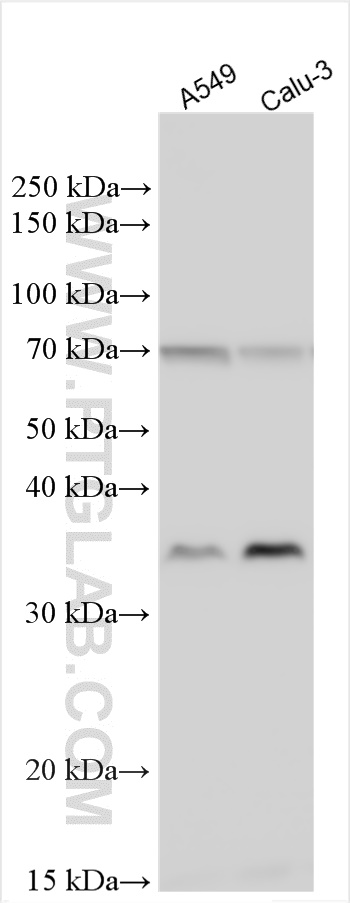验证数据展示
经过测试的应用
| Positive WB detected in | A549 cells, Calu-3 cells |
推荐稀释比
| 应用 | 推荐稀释比 |
|---|---|
| Western Blot (WB) | WB : 1:500-1:2000 |
| It is recommended that this reagent should be titrated in each testing system to obtain optimal results. | |
| Sample-dependent, Check data in validation data gallery. | |
产品信息
20288-1-AP targets FUT2 in WB, ELISA applications and shows reactivity with human samples.
| 经测试应用 | WB, ELISA Application Description |
| 经测试反应性 | human |
| 免疫原 |
CatNo: Ag14047 Product name: Recombinant human FUT2 protein Source: e coli.-derived, PGEX-4T Tag: GST Domain: 29-153 aa of BC001899 Sequence: QRLAKIQAMWELPVQIPVLASTSKALGPSQLRGMWTINAIGRLGNQMGEYATLYALAKMNGRPAFIPAQMHSTLAPIFRITLPVLHSATASRIPWQNYHLNDWMEEEYRHIPGEYVRFTGYPCS 种属同源性预测 |
| 宿主/亚型 | Rabbit / IgG |
| 抗体类别 | Polyclonal |
| 产品类型 | Antibody |
| 全称 | fucosyltransferase 2 (secretor status included) |
| 别名 | Alpha(1,2)FT 2, B12QTL1, Fucosyltransferase 2, FUT2, SE, Se2, SEC2, Secretor factor, sej |
| 计算分子量 | 343 aa, 39 kDa |
| 观测分子量 | 35-39 kDa |
| GenBank蛋白编号 | BC001899 |
| 基因名称 | FUT2 |
| Gene ID (NCBI) | 2524 |
| RRID | AB_3669331 |
| 偶联类型 | Unconjugated |
| 形式 | Liquid |
| 纯化方式 | Antigen affinity purification |
| UNIPROT ID | Q10981 |
| 储存缓冲液 | PBS with 0.02% sodium azide and 50% glycerol, pH 7.3. |
| 储存条件 | Store at -20°C. Stable for one year after shipment. Aliquoting is unnecessary for -20oC storage. |
背景介绍
Fucosyltransferase 2 (FUT2) is a key enzyme that catalyzes the transfer of fucose to the terminal galactose of type 1 or type 2 disaccharide via α1,2-linkage. FUT2 gene codes for the alpha(1,2)fucosyltransferase responsible for the synthesis of the H antigen, which is the precursor of the ABO histo-blood group antigens in body fluids and on the intestinal mucosa (PMID: 19487333). FUT2 is highly expressed in lung adenocarcinoma (LUAD) and plays a vital role in the tumorigenesis of LUAD (PMID: 36552800). FUT2 has a calculated molecular mass of ~39 kDa, and the 70kDa band might be the glycosylated form.
实验方案
| Product Specific Protocols | |
|---|---|
| WB protocol for FUT2 antibody 20288-1-AP | Download protocol |
| Standard Protocols | |
|---|---|
| Click here to view our Standard Protocols |


